The papaya, also known as Carica papaya, is an exquisite and versatile tropical fruit that not only delights our palates with its sweet and juicy flavor but also dazzles with its fascinating life cycle. From the humble seed to the lush ripe fruit, the papaya goes through a series of phenological stages that are not only crucial for its growth and development but also offer a window into the wonder of nature. In this exploration, we will delve into the phenological stages of the papaya, from germination to fruit ripening, uncovering the intricate processes that bring this tropical fruit to life, cherished around the world.
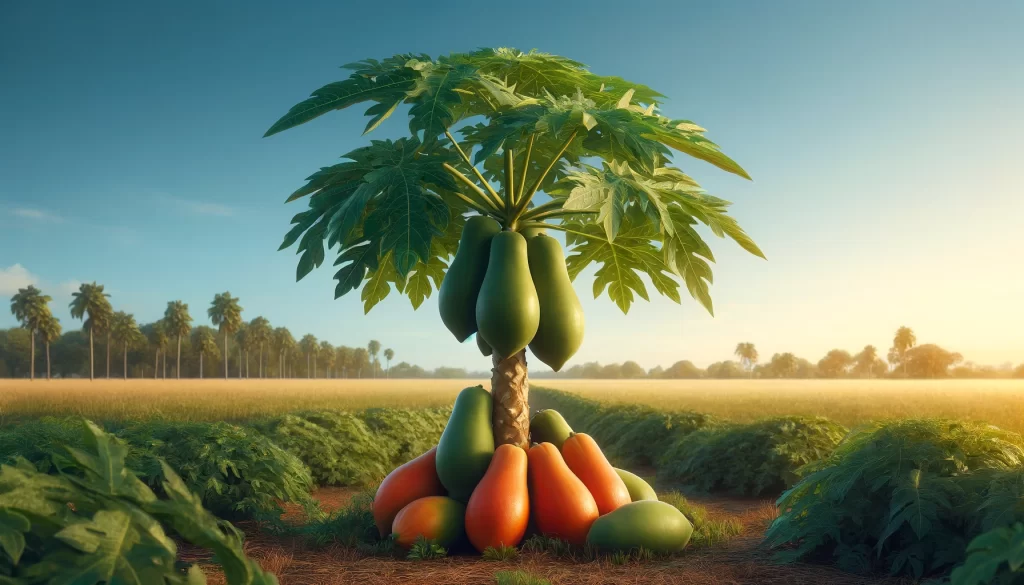
Seed Germination
The germination of the papaya seed marks the beginning of the exciting life journey of this tropical plant. This process is essential for the development of new plants and, in the case of papaya, is particularly significant due to its economic importance and wide distribution in tropical and subtropical regions worldwide.
When a papaya seed is placed in suitable conditions of moisture, temperature, and light, it begins to absorb water, activating the germination process. The outer shell of the seed softens and swells, allowing the seedling to emerge. As the primary root develops and stretches in search of nutrients and water in the soil, the sprout reaches towards the surface in search of light.
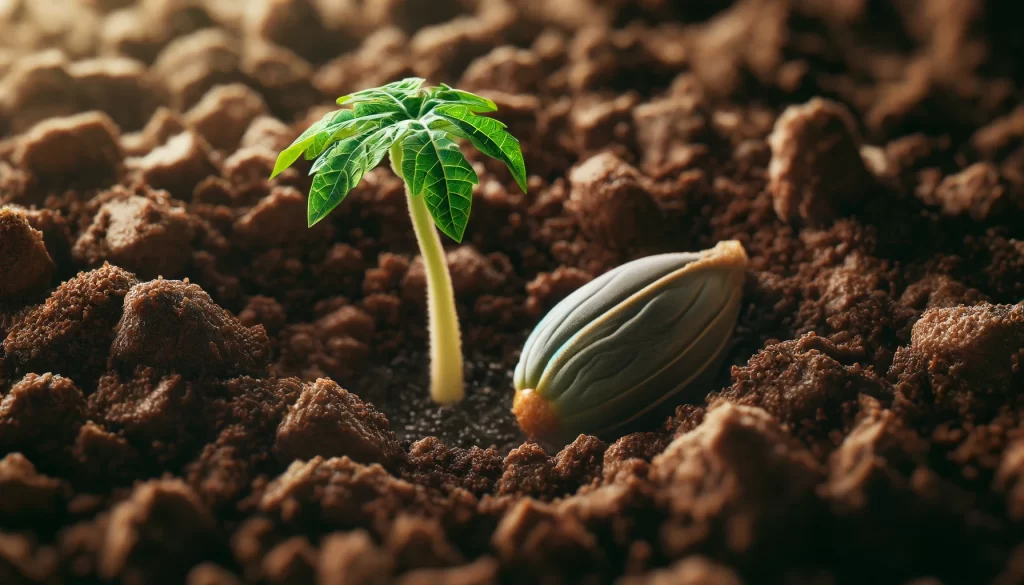
Papaya seed germination usually occurs within one to three weeks, although this period can vary depending on environmental conditions. It is important to provide a well-drained substrate and maintain a constant and warm temperature, ideally around 25-30°C, to encourage healthy seedling growth.
Once the papaya seedling emerges and establishes its roots in the soil, it begins its journey towards maturity, going through several phenological stages that will eventually culminate in the production of juicy and delicious fruits. Seed germination is, therefore, the first exciting step in the life cycle of the papaya, giving rise to new plants and promising the promise of abundant harvests in the future.
Seedling Establishment
The establishment of papaya seedlings marks a crucial stage in the life cycle of this tropical plant, where the young seedlings take root in the soil and begin to develop vigorously. This phase, following seed germination, is essential for the future success of papaya cultivation, as it lays the foundation for healthy growth and fruitful production.
Once the seedlings emerge from the soil, they begin to expand their roots in search of nutrients and water. During this initial phase, it is crucial to provide optimal growing conditions for papaya seedlings. This includes well-drained soil rich in organic matter, as well as an adequate supply of water and nutrients.
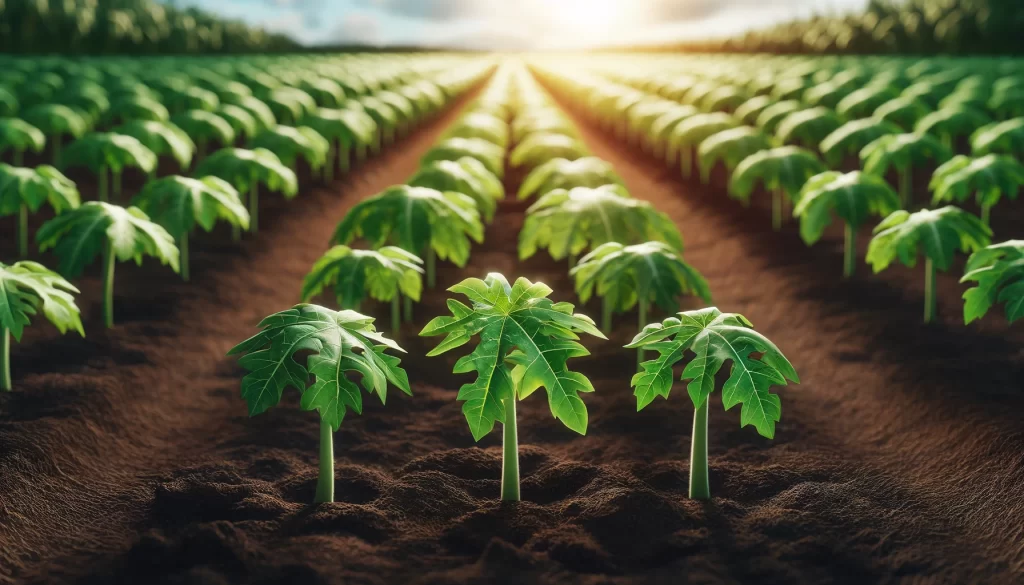
Adequate spacing between seedlings is essential to avoid competition for resources and allow for optimal growth. Papaya seedlings should be transplanted to their final location in the field or orchard with enough space between them to develop a robust root system and healthy vegetative growth.
During seedling establishment, it is important to maintain close monitoring of watering and fertilization to ensure an adequate supply of water and nutrients to the young plants. Additionally, weed and pest control is crucial to prevent unwanted competition and damage to papaya seedlings.
As papaya seedlings grow and establish in their environment, they are ready to enter the next phase of their vegetative development, where they will begin to produce new leaves and branches. Successful seedling establishment is, therefore, a fundamental step on the path to producing mature and tasty fruits, which will delight farmers and consumers alike.
Vegetative Development
The vegetative development of papaya is an exciting stage in the life cycle of this tropical plant, where it experiences vigorous growth and the formation of its vegetative structure. During this phase, the papaya plant focuses on producing lush foliage and strengthening its root system, preparing for the flowering and fruiting period that will follow later.
Once papaya seedlings have established in the soil, they begin to grow rapidly, producing new leaves and branches. This vegetative growth is favored by optimal environmental conditions, which include a warm temperature, adequate availability of water and nutrients, and sufficient exposure to sunlight.

During vegetative development, it is important to provide proper care for papaya plants to encourage healthy growth. This may include regular watering to keep the soil moist but not saturated, application of balanced fertilizers to promote vigorous growth, and weed removal to reduce competition for nutrients.
In addition to foliar growth, during this stage, the plant also develops a strong and extensive root system. A healthy root system is crucial for absorbing water and nutrients from the soil, as well as for providing stability to the plant as it grows and develops.
Vegetative development of papaya is a key indicator of the success of the crop and lays the groundwork for future fruitful production. Careful management during this phase ensures that the plant is well prepared for the next step in its life cycle: flowering and fruiting.
Flowering
The flowering of the papaya is an exciting moment in the life cycle of this tropical plant, as it marks the beginning of the fruit production process. During this phase, the papaya produces unique and distinctive flowers that are crucial for the formation of its tasty and juicy fruits.
The flowers of the papaya are generally unisexual and can be male, female, or hermaphroditic. Male flowers are distinguished by having long, thin stamens containing pollen, while female flowers have a large, rounded ovary that will develop into fruit after being pollinated. On the other hand, hermaphroditic flowers combine both reproductive organs in the same flower.
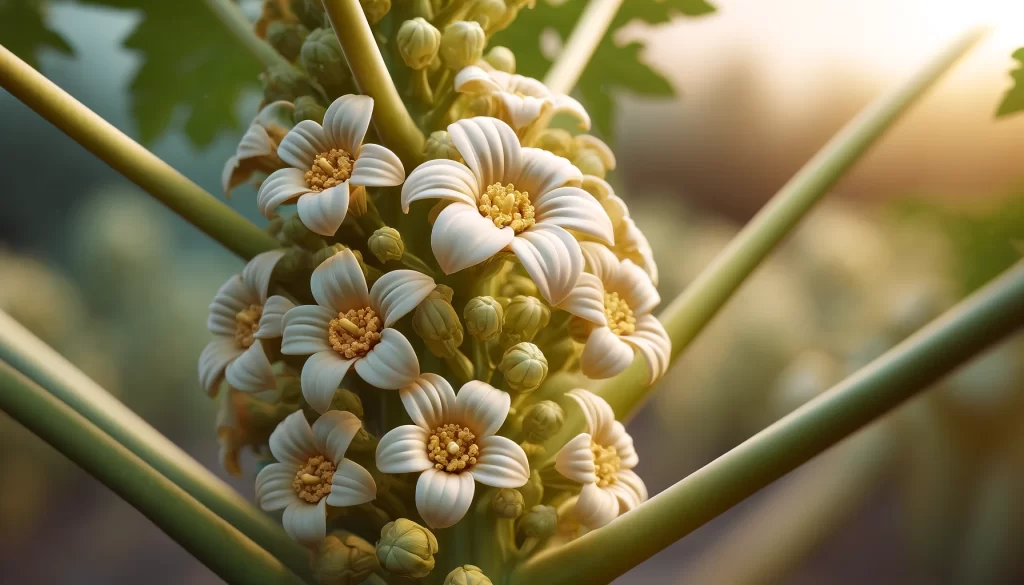
The flowering of papaya is influenced by various environmental factors, such as temperature, light, and availability of water and nutrients. Papayas tend to bloom best in warm, humid climates, and can produce flowers throughout the year in tropical regions.
Once the papaya plant reaches sufficient maturity, generally around 6-9 months after planting, it begins to produce inflorescences at the top of its main stem. These inflorescences contain a series of individual flowers that open sequentially over time.
During flowering, it is important to ensure effective pollination to guarantee adequate fruiting. In many areas, bees and other pollinating insects are responsible for carrying out this crucial process. However, in the absence of natural pollinators, manual pollination may be necessary to ensure a good fruit harvest.
Once pollinated, the female flowers of the papaya begin to develop fruits that gradually grow in size and maturity. The flowering process marks the start of the exciting journey towards the production of mature and tasty fruits, which will delight farmers and consumers alike.
Fruiting
The fruiting of the papaya is a crucial phase in the life cycle of this tropical plant, where the pollinated flowers begin to develop juicy and tasty fruits. This process is the result of successful pollination and marks the beginning of the formation of the characteristic papaya fruits that are so cherished worldwide.
After successful pollination, the female flowers of the papaya begin to develop fruits. These fruits start as small protrusions at the base of the flowers and gradually grow in size and maturity over time. During this process, the papaya plant channels a significant amount of energy towards the development and growth of the fruits.
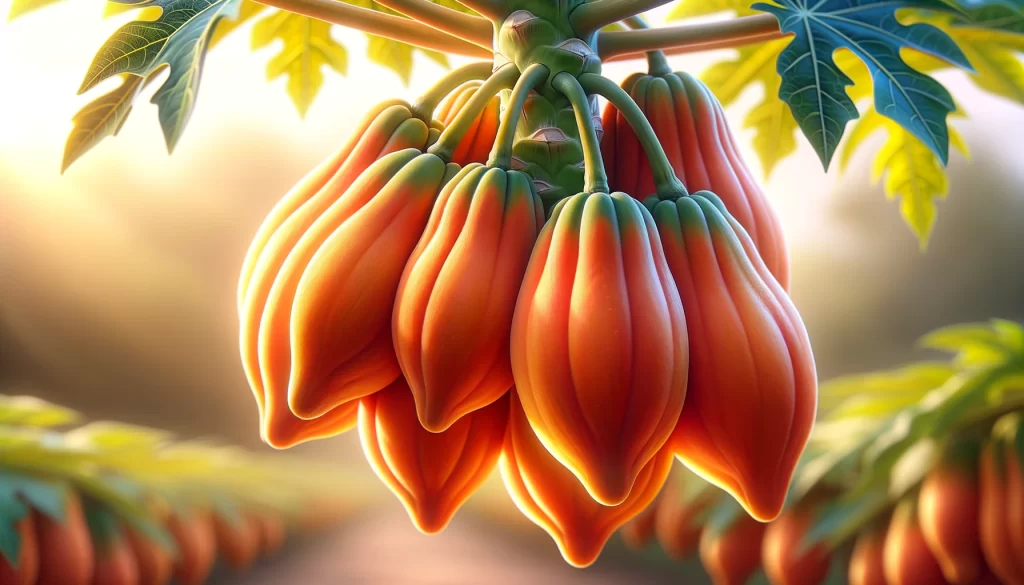
As the papaya fruits mature, they undergo a series of physical and chemical changes. Their color may change from green to yellow, orange, or even red, depending on the variety and degree of maturity. Additionally, the texture of the fruit’s skin becomes softer, and the inner pulp becomes juicier and sweeter.
The fruiting of the papaya can take several months, depending on factors such as climate, cultivation conditions, and the papaya variety. During this time, it is important to provide adequate care to the plants to ensure healthy fruit development. This may include regular watering, application of balanced fertilizers, and protection against pests and diseases.
Once the papaya fruits reach full maturity, they are ready to be harvested and enjoyed. Successful fruiting of the papaya is a testament to the care and attention devoted to the plants during their growth cycle, and rewards farmers with delicious and nutritious fruits that are appreciated worldwide.
Fruit Ripening
The fruit ripening of papaya is a fascinating and crucial process in the life cycle of this tropical plant. During this stage, the developing fruits continue their physical and chemical transformation, acquiring the distinctive characteristics of ripe papaya that are so appreciated for their sweet flavor and soft, juicy texture.
As papaya fruits ripen, they undergo a series of noticeable changes. One of the most visible changes is the shift in skin color, which generally evolves from an unripe green to a vibrant yellow, orange, or even red, depending on the variety. This color change is indicative of maturity and can serve as a visual signal to determine when the fruits are ready to be harvested.
In addition to the color change, ripe papaya fruits also exhibit a softer texture and a distinctive, sweet fragrance. The inner pulp of the fruit becomes softer and juicier, with a flavor ranging from slightly sweet to very sweet, depending on the level of maturity and the variety.

During the ripening of papaya fruit, it is important to provide adequate storage conditions to ensure the quality and freshness of the fruits. Ripe papaya fruits should be harvested at the right time and handled carefully to avoid damage that could affect their flavor and quality.
Once the papaya fruits reach full maturity, they are ready to be enjoyed fresh, added to salads, smoothies or juices, or used in a variety of sweet and savory dishes. Successful fruit ripening of papaya is a testament to the care and attention devoted to the plants during their growth cycle, and rewards producers with delicious and nutritious fruits that are appreciated for their exceptional flavor and health benefits.
Harvest
The harvest of papaya is an exciting and crucial moment in the cultivation cycle of this tropical plant, where the ripe fruits are ready to be collected and enjoyed. A successful harvest requires care, attention, and good judgment to determine the optimal time for picking.
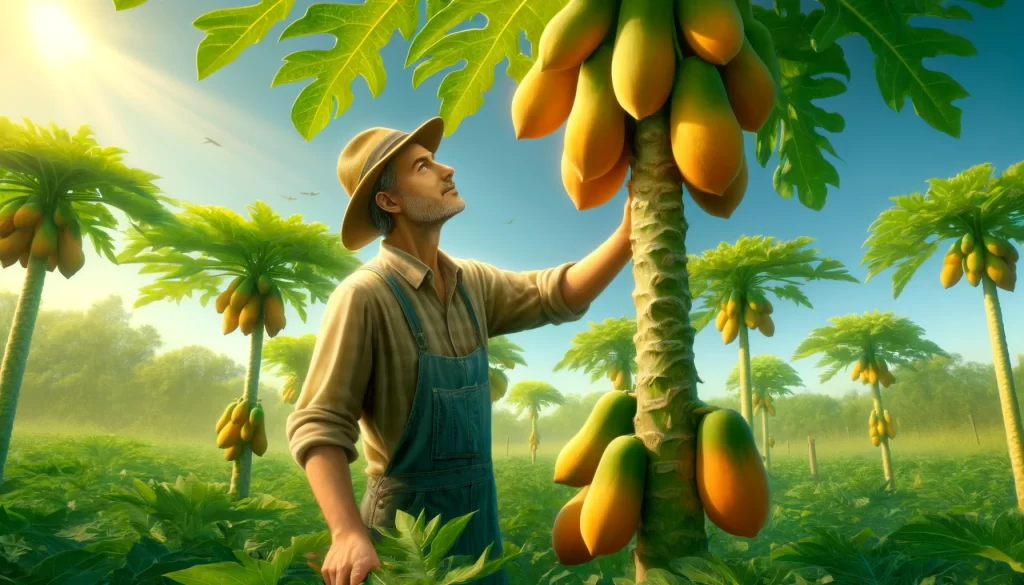
Here are some important guidelines to consider during the papaya harvest process:
- Maturity Determination: It is important to wait until the papaya fruits are fully ripe before harvesting them. Ripe fruits generally have a uniform color (yellow, orange, or red, depending on the variety), a soft texture to the touch, and a sweet and fragrant aroma.
- Visual Inspection: Before harvest, visually inspect the papaya fruits for signs of maturity, such as a uniform color and a skin that is slightly soft to the touch. Avoid harvesting fruits that are green or have spots or damage on the skin.
- Maturity Test: A common way to test the maturity of papaya is to gently press the skin with your thumb. If the skin yields slightly and leaves a slight mark from the pressure, the fruit is likely ripe and ready to be harvested.
- Proper Cutting: Use pruning shears or a sharp knife to cut the ripe fruits from the plant. Cut the fruit stem close to the base, leaving a small piece of stem attached to the fruit to avoid damaging it.
- Careful Handling: Handle the fruits carefully during the harvest to avoid damage that could affect their quality and durability. Avoid squeezing or crushing the fruits and handle them gently to avoid bruises or bumps.
- Adequate Storage: Once harvested, papaya fruits should be handled carefully and stored in a cool, dry place until consumed or processed. Avoid storing the fruits at extremely cold temperatures, as this can affect their flavor and texture.
The harvest of papaya is an exciting time that marks the successful end of a cultivation cycle and the beginning of the satisfaction of enjoying the delicious and nutritious mature fruits. With careful attention and observation, farmers can ensure a high-quality papaya harvest that is appreciated for its exceptional flavor and health benefits.
Stages of the papaya cultivation cycle with nutrient recommendations per stage
Here is a table showing the different stages of the papaya cultivation cycle, including the estimated duration of each stage, recommended activities, and nutrient needs:
| Stage | Estimated Duration | Activities and Care | Recommended Nutrients |
|---|---|---|---|
| Seed Germination | 7-14 days | Keep the soil moist. Provide indirect light. | N: 5-10 ppm, P: 5-10 ppm, K: 5-10 ppm |
| Seedling Establishment | 20-30 days | Transplant to individual containers or to the soil. Regular watering. | N: 50-100 ppm, P: 30-50 ppm, K: 50-100 ppm |
| Vegetative Development | 60-90 days | Regular fertilization. Keep the soil moist but not saturated. | N: 150-200 ppm, P: 100-150 ppm, K: 150-200 ppm |
| Flowering | 90-120 days | Monitor pests and diseases. Provide pollinators if necessary. | N: 150-200 ppm, P: 100-150 ppm, K: 150-200 ppm |
| Fruiting | 120-180 days | Monitor fruit development. Keep the soil moist. | N: 150-200 ppm, P: 100-150 ppm, K: 150-200 ppm |
| Fruit Ripening | 7-14 days | Observe changes in the color and texture of the fruit’s skin. | K: 200-250 ppm, Ca: 100-150 ppm |
| Harvest | Variable | Harvest ripe fruits. Handle with care to avoid damage. | – |
It is important to adjust nutrient recommendations based on soil analysis and the specific needs of the plant at each stage of the cultivation cycle. Additionally, integrated pest and disease management practices should be followed to ensure the health and productivity of the plant.
 AgronoBlog – Agriculture Blog
AgronoBlog – Agriculture Blog